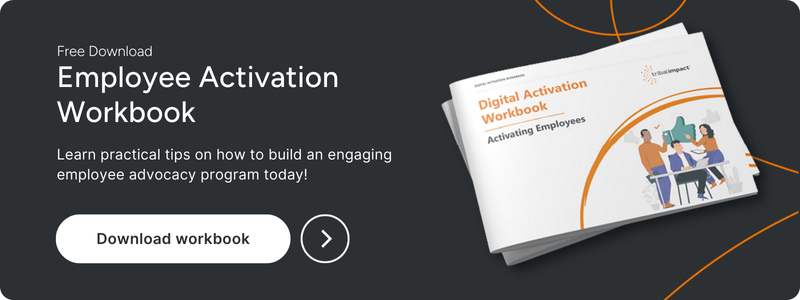If you’re implementing employee advocacy and social selling into your business, you’re looking to empower employees to act as ambassadors for your organisation and brand.
Employee advocacy and social selling help organisations increase brand awareness and build positive reputations by leveraging their employees’ social media presence and personal networks. Employee advocacy programs will help train employees to effectively share the brand’s message and content to increase employee engagement, satisfaction and loyalty.
However, implementing an employee advocacy and social media selling program on a global scale poses its own unique challenges.
Throughout this blog post, we’re going to discuss what those challenges are and ways in which you can overcome them.
What Are The Challenges Of Scaling Global Employee Advocacy And Social Selling?
Global employee advocacy and social selling programs can significantly benefit an organisation. Still, you must understand your challenges when dealing with global factors and cultural differences.
Cultural Differences
Firstly, you need to understand and adapt to the different cultural preferences of your employees. This includes communication styles and work habits of employees across different countries.
Employees in different countries may have different cultural norms. Regarding social media, this can mean they have different expectations of how they use their personal networks and what content they are comfortable sharing.
For example, some cultures may prefer to keep their professional, and personal lives separate, whereas others are more open to sharing their opinions and experiences. They may also have different communication styles, such as direct and indirect, so they may respond differently to messaging or approaches.
Logistics: Time Zones And Language Barriers
Managing employee advocacy programs across multiple time zones presents significant challenges, with travel and language barriers. Time zones can make communicating and coordinating with employees in different countries difficult. You can be in danger of delays or miscommunication.
In our recent LinkedIn Live with Danielle Guzman, Global Head of Social Media for Mercer, Danielle shared with us the importance of enabling people to act locally and think about your communications ecosystem.
Danielle highlighted, “We often think, ‘we need to get this out to our employees’, and when you’re using global platforms, it’s easy, click a button, and it goes. But what if it hits someone at 3 AM or 9 PM? You need to be respectful and thoughtful when you’re connecting and communicating. Make sure you connect when they are in a position to receive that conversation.”
Travel and language barriers can also impact the program if employees don’t fully understand the objectives and messaging. Organisations must implement well-planned and flexible programs that accommodate time zones and provide resources and support for multiple languages.
Communication And Collaboration
Effectively communicating and collaborating with employees in different countries are crucial for the success of an employee advocacy program. For the program to be effective, employees must be able to communicate as well as share ideas, feedback, and content.
In our LinkedIn Live with Alejandro Cabral, Global Digital Sales Transformation Leader at Kimberly-Clark Professional, he shared that the biggest issues he faced were the different time zones, the global model itself and how different each market is.
“Anything global requires being able to manage this and have multiple conversations with different departments at the same time.” Alejandro shared.
He also explained that it’s important to listen and pay attention to the status quo to figure out what will work in the region. You also need to consider what you’re working towards. That helps you determine employees’ maturity level and where to meet them when establishing digital in that area.
5 Ways To Implement Employee Advocacy On A Global Scale
As we’ve discussed, implementing an employee advocacy program globally can be challenging. However, if you have the right strategies and tools, you can successfully engage employees and achieve fantastic results.
1. Understanding Cultural Differences
It’s critical to the program’s success that you understand and adapt to different cultural preferences, communication styles, and work habits of employees across different countries. Using a tool like the Country Mapping Tool can help you compare how your global team’s different countries and cultures build trust, give feedback and make decisions. Knowing this information will help you to tailor your employee advocacy program accordingly.
2. Working With Logistics
To manage your program across multiple time zones and language barriers, you must provide adequate training, support, and resources. Your program should be designed to accommodate employees in different time zones and have resources in multiple languages to overcome language barriers.
3. Communicate And Collaborate
Effective communication and collaboration among employees in different countries will be essential for employee advocacy success. As well as considering time zones and language barriers, provide your employees with tools for real-time communication, such as virtual meetings, instant messaging, and shared workspaces.
4. Tailor Your Content
You must ensure your content is tailored to the different countries and regions. You should take into consideration local customs, traditions, and preferences. For example, it could be that video content is received better in some countries, and written content is preferred in others. Often, the best way to find out is to ask your employees!
5. Measure And Refine
One of the most effective ways to improve and scale your employee advocacy program is to continuously measure the program’s success and then refine the strategies and tools used. Ask your employees for feedback and take this into account to improve your program.
The Importance Of Global Employee Advocacy
According to a survey conducted by Gallup, only 21% of employees are engaged at work. This highlights the importance of effective employee advocacy and social selling programs to create a positive workplace culture and employee satisfaction.
Organisations can benefit from improved brand awareness, increased employee engagement, stronger relationships with employees and customers, and increased loyalty meaning they can attract and keep better talent.
Implementing an employee advocacy program is important; getting it right on a cultural and global scale is vital for multi-country organisations.

